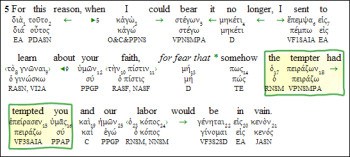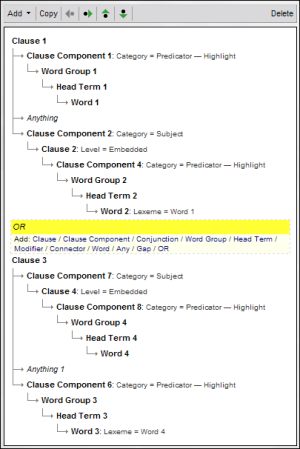I was reading in 1Th 3.5 the other day and came across the phrase “for fear that somehow the tempter had tempted you” (ESV). Here it is in the ESV NT Reverse Interlinear:
You can see the phrase highlighted using some of our new Visual Markup features. If you click and view the larger picture, you’ll see that the same lexical form (πειράζω) is repeated in the verse. Not only is it repeated, but one instance is the subject of the clause, the other is the predicator (verb) of the clause. The syntax graph from the OpenText.org Syntactically Annotated Greek New Testament shows this a little better:
Is this exegetically significant? Perhaps. But I also had the question — how many other times is the same word used as both subject and verb in the New Testament?
With syntax searching and Logos Bible Software 3, it is a relatively easy question to answer.
As an added bonus, I’ve even included a video of setting up the search. This video is the first in which you’ll hear my “smooth dulcet tones” (as the colleague sitting next to me describes it) narrating the action. You can try the video (Flash, 12 megs, with audio) but be sure to read the description below the fold as well.
Let’s put this into terms of the OpenText.org syntactic annotation. Then we can use the Syntax Search dialog to create the query.
We’re looking for a clause that has a subject and predicator that have the same underlying dictionary form (or lemma, or lexical form) of a word. Even more specifically, the clause must have a predicator component (verb) that contains a word group; the word group contains a head term; and the head term contains a word. It is this word that has the lexical form of the word in question.
The same clause must have a subject component. The subject component contains a word group; this word group contains a head term. The head term of the subject gets a little complicated, though. As the word in question is a verb, this means that if the verb is a subject, it must be a substantive participle a verb functioning substantively in the clause. We can find this specifying that the subject component contains an embedded clause as verbs imply new clauses (embedded, secondary, or otherwise). That embedded clause, then, contains a predicator component; that predicator contains a word group, and that word group contains a head term that has the dictionary form from the parent clause predicator.
After the basic structure is set up, we need to add the important part to make sure that the same word occurs in both word objects. Clicking on the second word, we simply specify that the second word’s Lexeme option agrees with the first word’s Lexeme option.

That’s right. We specify agreement between the two lexical forms. In the syntax search dialog, agreement isn’t necessarily just for morphological criteria. Each database supports differing agreement options, and each object in each database supports differing agreement options.
Further enhancements to the query would be to place Anything blocks between both clause components. After that, add an OR block, and copy the structure. Then switch component order. This will find where we have the order Subject > Predicator, and also the order Predicator > Subject.
Like the sample below:
Here’s the video:
When you run the search, you’ll find 60 occurrences of the phenomenon in the New Testament. Fun stuff! And not exactly easy to do outside of syntax searching. If we’d simply searched for repeating lexical forms, we’d have a number of hits involving the Greek definite article to weed out, or perhaps other sorts of things.
Searching by syntax allows us to bound our searches according to syntactic constraints and then specify things (morphology, agreement, lexical forms, etc.) at the word level within the established syntactic constraints.







